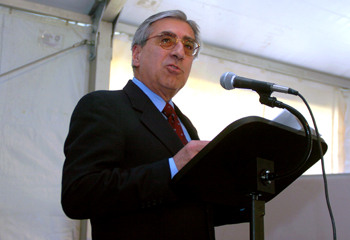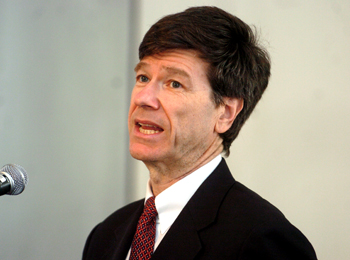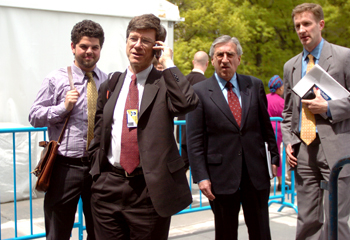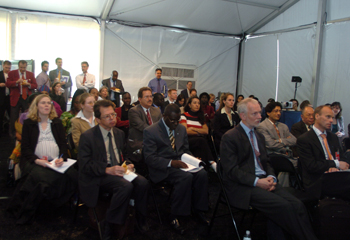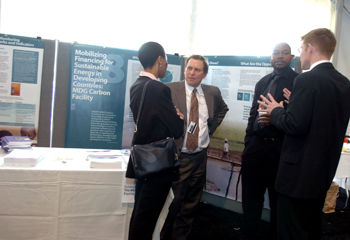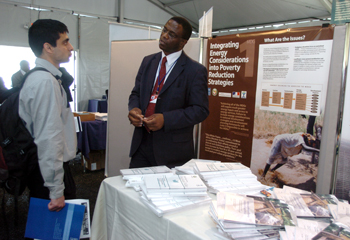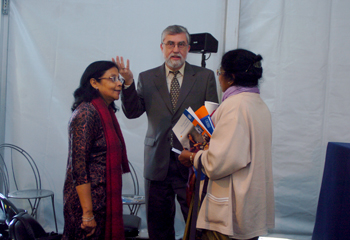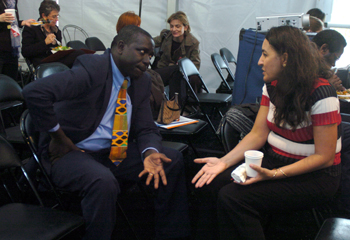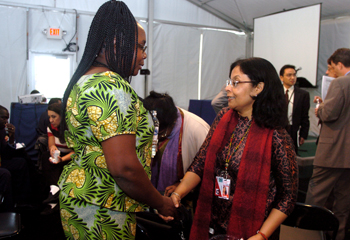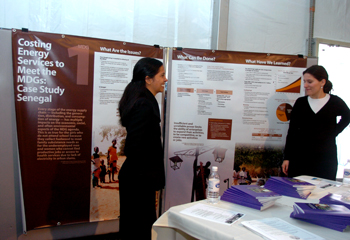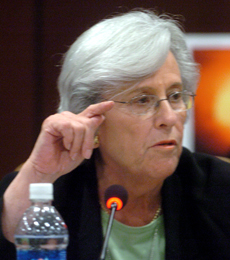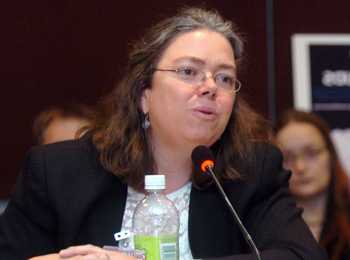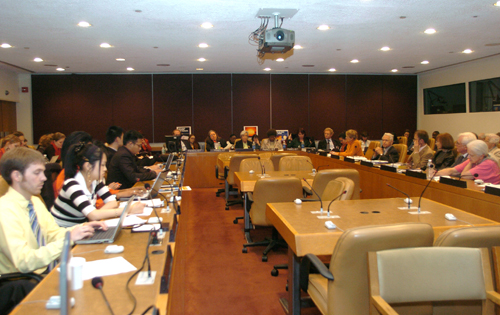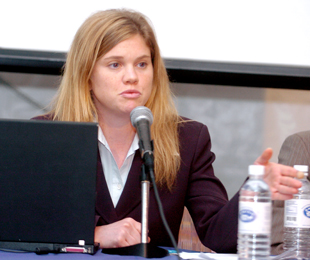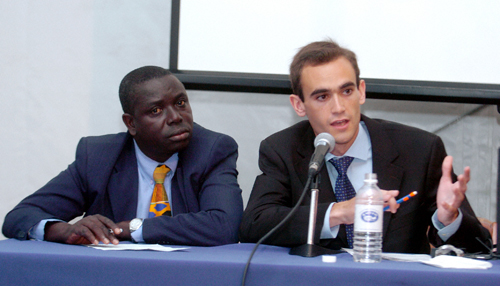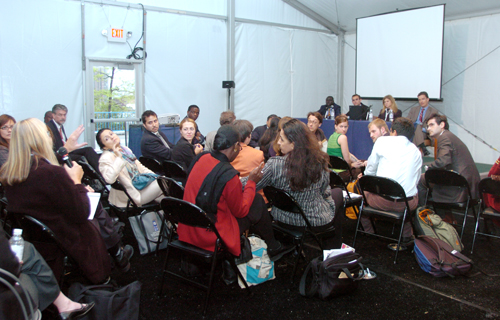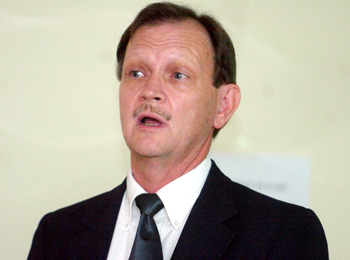 |
||
|
published by IISD, the International Institute for Sustainable Development
in cooperation with the UNDP Secretariat |
|||
|
Special Report on Selected Side Events at the Fourteenth Session of the Commission on Sustainable Development (CSD-14)
|
|||||
| 1-12 May 2006 | United Nations Headquarters, New York | |||||
 |
 |
|||
 |
||||
Events convened on Wednesday, 3 May 2006
|
Energy for Achievement of the MDGs Presented by UNDP |
||
|
Luis Gomez-Echeverri, UNDP, opened the UNDP Knowledge Showcase and panel discussion, which presented experiences from around the globe and launched the “Energizing the MDGs” report.
Jeffrey Sachs, Columbia University, noted that although the MDGs do not mention energy needs explicitly, they are inextricably linked. He stressed the need for a pragmatic approach to energy development, and noted that the “Energizing the MDGs” project is the first time such targets for energy services have been developed. Highlighting that the associated costs of providing sufficient energy services to meet the MDGs are relatively low, he said that overcoming neglect is the major barrier. He said that development efforts should focus on securing access to energy for the world’s poor, and that sourcing this from renewable energy is a secondary consideration. Vijay Modi, Columbia University, said the time for making commitments has passed, and called for the galvanization of support and mobilization of resources within relevant national agencies to make real changes. He identified several barriers to implementation, including the debate over promoting renewable versus conventional fuels, and taking an “all or nothing” approach to energy provision. Susan McDade, UNDP, noted the importance of distinguishing between energy and electricity needs and emphasized that the absence of clean heating and cooking fuels is a greater burden than the absence of lighting. Noting that respiratory diseases caused by poor ventilation are the 4th largest source of mortality in the developing world, she said that alternative technologies and fuels such as liquid petroleum gas (LPG) have yet to be made accessible in poor areas. She lamented that often household fuel policy is fragmented and not seen as an integral part of energy planning. Tom van der Zon, Netherlands Ministry of Foreign Affairs, commented on why the problem of access to energy has not improved, saying that up-front investment often takes the lion’s share of project funding, with little reaching affected people. He highlighted an upcoming project initiated by the Netherlands that focuses on enabling energy development for 10 million people by 2015. Participants discussed: challenges associated with communicating the MDGs and the need for them to explicitly consider energy needs; the potential for incorporating renewables; enabling access to multi-lateral funds for new technologies; and the need to scale up smaller projects. |
||
Around the Side Event
|
|||
|
Myths and Realities: Nuclear Power, Climate Change and the Proliferation of Nuclear Weapons Presented by Greenpeace International and Global Resource Action Center for the Environment |
||||
|
Steve Sawyer, Greenpeace, emphasized that climate change presents a clear, immediate threat, with only a small window of time to achieve stabilization – an increase of no more than two degrees Celsius. Sawyer underscored that nuclear energy is not a viable option, due to: the large number of reactors required to handle vast energy loads; their extended construction times; lack of market interest; and excessive financial and environmental costs. He highlighted the surge of renewable energy businesses and emphasized energy efficiency as an extremely effective pathway for reducing GHG emissions and meeting global energy needs. Mary Olsen, Nuclear Information and Resource Service, stressed that nuclear power is not the answer to global energy requirements, as it is regressive and leads further away from a true solution. She highlighted reasons why nuclear is inappropriate, including that: fossil fuels cannot be phased out when using nuclear energy; it releases massive amounts of thermal pollution; it is not cost-effective; it is vulnerable to extreme weather as it relies on the power grid; and it has to be shut down during high temperatures. Olsen accentuated that reducing energy demand is the cheapest, cleanest, most creative, democratic solution. Hilda Lini, Melanesian Institute of Philosophy and Technology, discussed nuclear energy and climate change from the perspective of indigenous peoples, highlighting their philosophy as embodying “peaceful coexistence.” She said that the process of creating nuclear energy is a threat to indigenous peoples throughout the process, from mining uranium, to building power plants, to possible leakage. She addressed who benefits from nuclear energy and whether it is a need or want, and posed the question of whether the world needs an energy source that threatens the world’s climate and human lives. She closed by saying that if people are committed to tackling climate change then clean energy and renewable energy are solutions that align with peaceful coexistence. Felicity Hill, Greenpeace, discussed a paper, “Nuclear Power: Unsustainable, Uneconomic, Dirty and Dangerous,” explaining that it assesses nuclear energy against the Johannesburg Plan of Implementation– calling for “reliable, affordable, economically viable, socially acceptable and environmentally sound” energy sources. She explained the schism in the International Atomic Energy Agency's mandate of non-proliferation and protection of the “inalienable” right and stressed that both the materials created by nuclear power plants and the plants themselves pose a security risk. Hill emphasized that for peace, security and sustainable development to exist, nuclear programs must be abandoned in favor of renewable energy. Discussion: Participants addressed: advances in nuclear energy in light of the rapid depletion of fossil fuels; data on work-related injuries from various energy technologies; ISO’s costing of energy system technology; the need for all available sources of energy; and nuclear energy materials for youth. |
||||
|
|||
|
Sharing Lessons on National Energy Intervention Presented by UNDP and Columbia University |
||
|
Aynsley Toole, Columbia University, described a project that developed a methodology to estimate the cost of providing enough energy to developing countries in order for them to meet the MDGs, using Senegal as a case study. She noted that the project focused on providing energy for modern cooking systems, electricity, and mechanical power, and that it set goals for increased service. For Senegal, she reported that meeting these goals would cost an estimated US$1.7 billion over 10 years, mostly for capital outlays and fuel and electricity purchases, amounting to US$12 per person, per year. She described methodologies used and limitations associated with the project, including that it does not consider sources of funding for the energy.
Arnaud Algrin, Columbia University, provided further details concerning project outcomes, including estimated costs associated with the introduction of LPG and modern cooking stoves (US$730 million over 10 years), mostly associated with fuel. He noted that the provision of electricty considered costs associated with three options: extending the current main grid, establishing mini-grids, and introducing photovoltaic systems. He reported that the main grid option was the most cost-effective (US$588 million over 10 years). As for increasing access to power for agro-processing and other mechanical needs, he reported that this would require US$345 million over 10 years. Louis Seck, Ministry of Energy and Mines, Senegal, thanked Columbia University and UNDP for carrying out the project, noting that Senegal is now much better informed regarding energy needs, which he believes is crucial for achieving the MDGs. He described Senegal’s multi-sectoral strategy for securing energy for poverty alleviation, which has brought together many ministries, including finance, education, and agriculture, as well as the private sector and civil society. He then elaborated on Senegal’s national program for investment into energy services, including electricity needs, cooking and mechanical processing needs. Participants commented on the tangibility of the research presented, economies of scale, the need to distinguish between rural, urban and peri-urban energy needs, and the additional costs and considerations associated with the introduction of new technologies; and the minimum data requirements in order to carry out such an analysis. |
||
|
|||
|
Tidal Energy for Sustainable Development and Adaptation to Climate Change Presented by the Pan African Movement |
||||
|
Thomas Goreau, Global Coral Reef Alliance, described tidal energy, noting its worldwide distribution, particularly in the Pacific and Indian Ocean. Goreau stressed that tidal energy is: non-polluting; efficient; uses inexhaustible, renewable, and untapped energy resources; offers multiple benefits at both the small and large scale; and that it is a practical and cost-effective solution to replace fossil fuels. He then described the helical turbine, which captures tidal energy without the use of dams, and highlighted tidal energy as the most cost effective source, of energy, although it has not been widely recognized. Noting the pressing issue of climate change, Goreau said that even if no more fossil fuels are burned beginning today, global temperatures would still become hot enough to cause coral reef damage and bleaching even greater than it is today. He then described Biorock, a technology which uses an electric current to grow solid limestone rock structures in the sea, catalyzing reef growth and re-establishment. He said that in the future, tidal energy combined with Biorock technology can be used to protect low-lying islands and coasts, and restore coral reefs and fisheries damaged by global warming. He closed by highlighting the need for a programme to create and apply tidal energy word wide for sustainable development and emphasized that tidal energy deserves to be included in the list of sources of sustainable energy supported by various conventions. Scott Anderson, The Tide-Energy Project, described two projects: the Tide-Energy Project, near the mouth of the Amazon River, and the Uldolmok Strait Pilot Project in South Korea, both of which utilized the helical turbine technology at a small scale and large scale respectively. Anderson emphasized that 90% of the Tide-Energy Project’s station can be built using locally available materials and equipment, except for the helical turbines blades. He highlighted the projects’ goal of using tidal energy to generate electricity that is economical, and environmentally sound. He closed by saying that pending sufficient funding a pilot phase will be initiated, and if this proves successful, the results will be applicable worldwide. |
||||
|
|||
|
||
|
Click the above button to go back to our ENB main coverage
|
||
|
|
|
|
|
||
|
